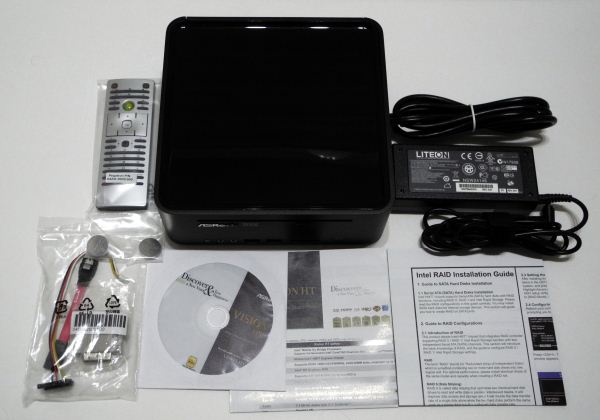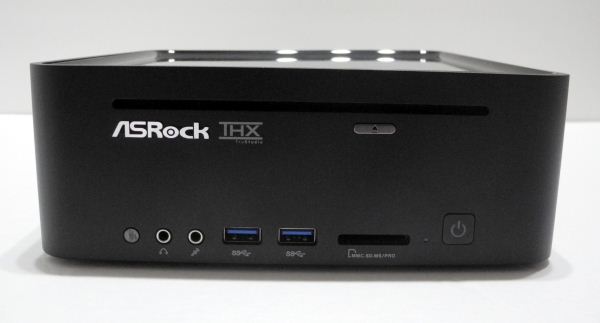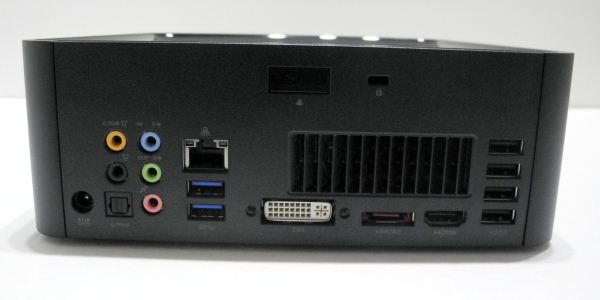ASRock Vision HT: Ivy Bridge Carries the SFF HTPC Forward
by Ganesh T S on November 12, 2012 3:30 PM EST- Posted in
- Home Theater
- ASRock
- HTPC
- Ivy Bridge
Unboxing Impression
The ASRock Vision HT 321B package contained the following:
- Main unit in a 2.5L chassis (195mm x 186mm x 70mm)
- 90W AC / DC adapter
- Media Center remote with batteries
- Support CD with drivers and miscellaneous software
- DVI- VGA dongle
- SATA and power cables / screws for user installation of second hard disk
Unlike the CoreHT 252B, the industrial design of the Vision HT traces its roots to the Vision 3D series. We have pleasing rounded edges, though the chassis doesn’t have a unibody construction. ASRock deserves credit for bringing the industrial design of the high-end units to the mid-range segment this time around.
When compared to the Core HT from last year, we find that the two USB 3.0 ports and the microphone / headphone jack in the front panel are retained. However, the power button changes from a circular version to a square with rounded edges. A SD card reader also makes an appearance. There are no ventilation slots in the front panel this time around.
Just like a notebook, this unit also supports simultaneous display on two monitors. Testing was done mostly with the HDMI output connected to a Sony KDL46EX720 1080p 3D TV through a Pioneer Elite VSX-32 AV receiver. For non-media playing related testing, the HDMI port was connected to an Acer H243H 1080p monitor. Our review unit shipped with Windows 7 x64 Ultimate and a OEM version of Cyberlink PowerDVD for Blu-ray playback. However, the OEM version doesn't support 3D Blu-rays and is also crippled with respect to the number of audio channels that can be decoded / HD audio passthrough. To test these, we installed the full versions of both Cyberlink PowerDVD 12 as well as ArcSoft Total Media Theater 5.
We will conclude this section with a table to summarize the data and A/V connectivity options for the ASRock Vision HT 321B HTPC.
| Option | Status |
|---|---|
| HDMI | Yes [v1.4a] |
| Component | No |
| Composite | No |
| VGA | Yes |
| SPDIF | Yes [Optical] |
| Stereo | Yes |
| Option | Status |
|---|---|
| Optical Disk Drive | Yes [Blu-Ray / DVD-RW] |
| USB | Yes [4 x v2.0, 4 x v3.0] |
| eSATA | Yes [1 x v3] |
| LAN | Yes [ 1000 Mbps GbE ] |
| Internal HDD | Yes [ 500 GB ] |
| WiFi | Yes [ 300 Mbps 2T2R 802.11n (Dual band)] |
| Bluetooth | Yes (v 4.0) |
| Card Reader | No |













40 Comments
View All Comments
shurik_1 - Monday, November 12, 2012 - link
Could you test the silent data corruption issue I have described in Vision 3D comments? With Vision 3D it is still an issue when 16GB RAM are installed (with 8GB RAM they fixed it via BIOS update that they did not make publicly available) and ASRock although acknowledges its existence refuses to fix it.ganeshts - Monday, November 12, 2012 - link
I will follow up on this with ASRock. That said, I have been using the Vision HT / Vision 3D 252B to unpack a number of split archives (around 400 MB each unpacking to ~4.37 GB / ~10 GB) and not found any issues so far.But, definitely an interesting case (if there is some data corruption with a different DRAM, that may point to some issue in the DRAM module itself). Are you aware of any other users with the same issue? I am trying to see if there is something common between all the systems exhibiting this problem...
shurik_1 - Monday, November 12, 2012 - link
It will not complain at unpack because my thinking is that corruption occur at writing (at some point in my lengthy mail exchange with ASRock support Intel ME was mentioned as the culprit). I discovered the issue because par repair invariably fails on large file sets. That is why I call it silent. Did you try to create checksum of archive content and test after unpack? I have only one set of laptop 16GB modules. But when my 2nd gen Vision 3D had BIOS prior to 1.10c ("c" suffix is important here) it was present with 16GB and two different sets of 8GB modules.klmccaughey - Monday, November 12, 2012 - link
I don't understand why manufacturers can't release a cheap HTPC. It is still much more cost effective to build your own.Every time I see one of these reviews I get excited, and every time I get disappointed as I see the outrageous price tag.
EnzoFX - Monday, November 12, 2012 - link
I too wish there were cheaper alternatives. I myself have no need for optical (Ew), and am usually eyeing those tiny foxconn's that use E-350's. Though I'd more likely go with something with more performance.Perhaps this segment is too much of a niche (Probably). Intel's NUC looks promising, hope it becomes standardized so that the race to the bottom can start on those chips =P.
lurker22 - Monday, November 12, 2012 - link
Avoid the 350. Yes it will work, but a lot of use end up being slow on it especially when the GPU acceleration isn't available.StealthX32 - Monday, November 12, 2012 - link
From what I've read on a few Newegg reviews, you can get a Broadcom BCM9700xx hardware decoder card to put into the miniPCI-e slot and achieve <20% CPU utilization on even high bitrate 1080p material.I bought this from them when they had the buy an HTPC get a free SSD combo, but haven't gotten around to buying the Broadcom card yet.
lurker22 - Monday, November 12, 2012 - link
As I said, it's doing everything outside of the GPU accelerated videos that ends up being very slow. Web browsing, Netflix, etc is all CPU limited.BuddyRich - Monday, November 12, 2012 - link
Netflix via website and silverlight is bad.Youtube HD is GPU accelerated and Netflix Win8 also works nicely.
One of the few pluses of Win8!
Pipperox - Tuesday, November 13, 2012 - link
I have an E-350 based Zotac Nano.It's absolutely silent, can play most media content without a hitch (haven't tried 1080p60 content though, but 24 and 30Hz are not a problem) and with Windows 8 internet browsing and general PC usage is butter smooth.
Sure, i wouldn't do media transcoding or rendering or content creation on such a PC, but for the value and intended use I couldn't be happier.